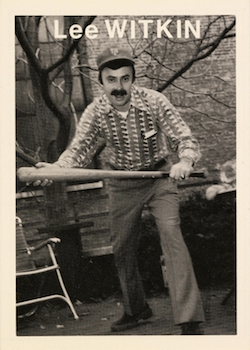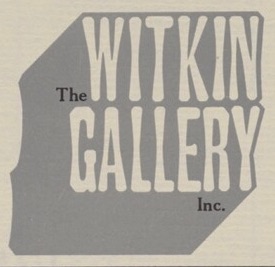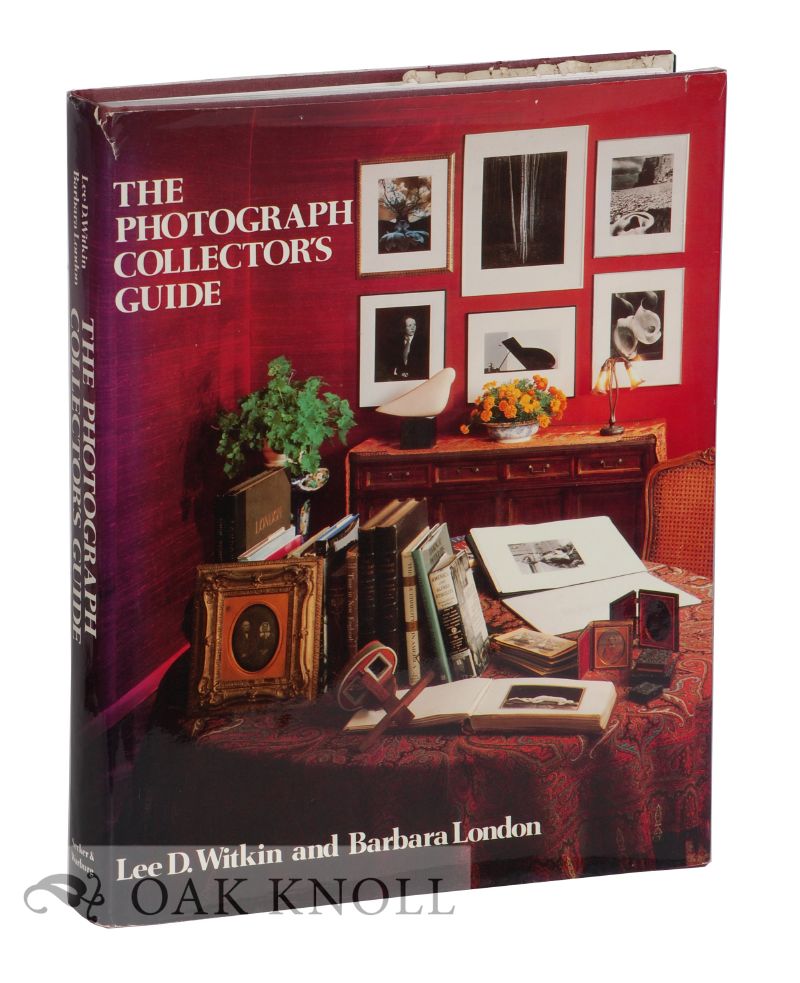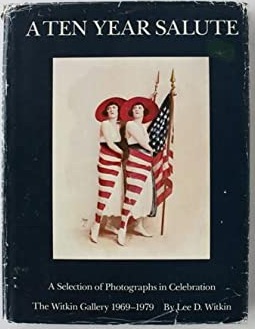 [Lee Witkin opened his pioneering, eponymous photography gallery in 1969, the year after I published my first column of photography criticism in the Village Voice.
[Lee Witkin opened his pioneering, eponymous photography gallery in 1969, the year after I published my first column of photography criticism in the Village Voice.
This interview was conducted at Lee’s apartment on 57th Street, which was within walking distance from his gallery, then located in the Fuller Building at 41 E. 57th. It took place on September 9, 1980. Under the title “Interview: Lee Witkin,” this appeared 40 years ago in the short-lived magazine Photoshow (Vol. 1, no. 4, May 1981). Part 2 appears below. Click here for Part 1, and here for Part 3. — A.D.C.]
•
Interview: Lee Witkin (continued)
ADC: … What do you see as your obligations … to the photographers you deal with, to the other galleries you deal with, and to collectors in the field who you’re selling that material to?
LW: My obligations are what they always were: to find the people whose work I admire and — if they indeed wish to be represented by the gallery — to show the work to the best advantage, to take care of it, to see that it got into the hands of good collectors and good institutions, and that they got money and/or books and whatever they wanted in the way of fame and fortune. To sell something for them, because money is a very important factor too; it’s turning out that money is probably the most important factor. So that has been and always will be and is a consideration.
Most of the people I represent I know, I get to know as people, and they get to know me. That was true with [Margaret] Bourke-White and [Edward] Steichen and Imogen [Cunningham]; it’s true today with Wendell MacRae, Judy [Dater], Jerry Uelsmann, Doug Prince. Most of the people I represent are my friends; they come into my house, I go to their house. I know it’s their work — I get it from them. I can tell the collectors this is their work.
I can smell something wrong a mile off. I always say to someone [who brings material into the gallery for sale], “Where did you get this, and do you have the right to sell it?” And nine times out of ten, they’ll say, “Well, we’ll get back to you,” and out the door they go. So I try to stay away from a situation of fraud, or theft, or misrepresentation.
I always try to deal directly with the photographer, or a son or daughter, so that I know what I’m dealing with, so that I can tell the people who are buying from me, “I know this is Gene Smith’s print because I got it from Gene.” And Gene was my friend. Gene’s not going to be represented by the Witkin Gallery any more, but that doesn’t make any difference to me, because I cared more about Gene Smith, and his love for me and my love for him and what our relationship meant — in his whole life I was the only gallery that he chose to have — than what’s happening now that he’s dead.
I don’t think I have responsibilities to other galleries, other than to present myself as a good model. If a man lives a good life, he’s there to be seen.
•
LW: … I went to galleries for years [before opening his own], and I went to the places I liked — I liked the way people talked, the way they showed me the material, I liked the stories that were told me by certain dealers, I liked the rapport — and when I opened my gallery I said, “I want my gallery to be like that.” Because those people seemed to me to embody the best in dealers, and their establishments seemed to me sanctuaries, in which I sought hours of solace and contentment. And then I fashioned my gallery.
Naturally, the Witkin Gallery is reflective of other places that have existed — because I decided to fashion it after those examples. I didn’t go to those people and say, “Tell me what to do; help me run the gallery.” I had enough energy and initiative to decide for myself what I liked and disliked from what I saw, and then to do it myself.
•
LW: … It’s not right, and it’s not wrong, it’s just a fact of life: If someone can buy up an estate, then that individual has the power to do whatever he likes with it. And you might say it’s unfair, but that’s tough — that’s the way the world is. That’s America, and that’s today, and that’s the way it is. As to what you can do about it — use common sense. You don’t have to deal with people you don’t admire. I have severed a lot of relationships with people whose behavior patterns and philosophies were not mine. I’m not saying that they were criminal, or wrong, or even unethical; they were just not on my ethical wavelength, and I could not deal with that.
People who, sometime in a relationship, do things like that, lose a kind of credibility for me, and I can’t be false to people. I suppose that’s cruel, and really stupid. Somewhere along the line I should have developed a middle ground where I could get along with the people I didn’t agree with. That may be my biggest flaw: If I can’t get along with somebody, I just sever the relationship. …
What I see for the future of artists working in the medium of the photograph is a total integration into the art scene. I see the future for my gallery as representing artists whose work I admire. Period. I don’t think photography has to be isolated anymore. I think perhaps this is the time to stop showing photographs and to show the photographer — to stop getting the medium confused with the man with a vision who used it.
And I think whether this photography dealers’ association likes it or not, it may be obsolete before it begins. Because the major galleries across America are integrating photographers into their stables. And I honestly believe that is the right thing. I think once you go to see a show by André Kertész or Edward Weston or Judy Dater or George Tice — no matter where it’s held — because you’re going to see what Tice has done, what Dater has done, what Weston has done, what Kertész has done, that’s what you’re going to see. That’s what’s important. The photographic medium was neglected and underrated; that doesn’t exist any more. So it may be time to let go of keeping photography as a medium all to itself, and let it go into that large sea of art where it properly belongs.
ADC: I know that’s started to happen — gradually over the last ten years, but certainly very visibly over the last five or six years, with a great many of the major art galleries beginning finally to integrate photography that way. And I know that in some ways you’ve paid a price for that, the price being that number of photographers who’ve been associated with your gallery have been — I don’t know what word to use: courted? seduced? extracted? stolen? married off?
LW: Lured away?
ADC: How do you feel about that?
LW: One of the people I owe most to is Berenice Abbott, because she helped me from the very beginning. She’s a woman whose character and whose talents I admire tremendously. I find that she can be a kvetch, and a difficult woman, but beyond that crust there’s a human being who possesses so many admirable qualities that I almost gasp at how fine Berenice Abbott is. And when she went to this other gallery, she told me — she said, “I’m doing it for the money, and it’s only for five years. So wait.” And indeed I have been getting prints from her again, now that that deal is over.
I can’t tell anyone who’s starved most of his life to turn down a lucrative offer from another gallery; nor would I, because I think it would be unfair. If I have a photographer who needs money or wants money and it’s somewhere else, and he feels that he can get it without compromising too much of his integrity, then I think he should do it, and I have no bitter feelings about it. I really don’t.
For every photographer I’ve lost, I’ve found another good one. At the beginning I was frightened, because I thought that was the end of me. But I’ve since learned to have confidence, that the show goes on and there are a lot of good photographers. If I lose some, I’ll gain others. I can only show that many anyway.
So I don’t feel bitter about it, and I don’t feel that people should. It’s going to happen more and more. The more lucrative the selling of photography becomes, the more competition over representing the various photographers, especially the ones whose work sells. It’s natural. … Right now, it’s an artist’s market. He can pick and choose from dealers . . .
ADC: Do you work on a contractual basis with photographers?
LW: I never did — never did. I always had a gentleman’s agreement with everybody. Because a contract can be broken, and I’m not a lawyer. I have now gotten to a point where we draft up a letter of agreement, but I’m sure those letters of agreement would go PFFT! the first time they were contested.
If someone doesn’t want to be with me, I don’t want that person to be with me — it’s terrible. I don’t want to have a gallery that represents people who don’t want to be represented by me. And I don’t want the kind of power over them that would make them yield to my control whether they liked it or not.
ADC: Is there a set percentage of sales that you take — and is that constant, or has it changed over the years?
LW: It’s basically always been forty per cent, and when we buy outright or when we do a show now we take fifty per cent during the show, because of the expense of the show. That’s pretty standard. … I’m basically a very democratic person. I like to set up a rule and it applies to everybody. Whoever comes to my gallery receives the same courtesy, until he abuses it, rich or poor. Whoever I represent, it’s the same terms, whether it’s a young photographer or an established one. It keeps it nice and clean — there are no separate deals for separate people that people find out about and say, “Why did you do that for him and not for me?”
It’s a lot easier to set rules that are fair, and to live by them, than to wheel and deal, because eventually the wheeling and dealing causes you nothing but problems. They say honesty is the best policy, and I really believe that it is … I’ve lost some people because I couldn’t come up with a better offer, but in the long run I’m better off that way. I do believe in equality for all people. It makes it so much simpler.
ADC: The gallery’s been involved in publishing portfolios now for — eight years or so?
LW: No, we published our first portfolio almost ten years ago — 1970.
ADC: More recently, you’ve been publishing small books — somewhere between a monograph and a catalogue — on such people as Wendell MacRae and Doug Prince. I take it you see that as a logical extension of the work of the gallery. I’m wondering how well those programs have gone, and also if it causes problems for you as a gallery owner to make decisions as to which of the many people you represent you’re going to sponsor in that way. How is that decision made?
LW: In the beginning, I didn’t have the kind of money needed to do monographs and catalogues. Now there is more money coming in, so we put more money out into things like that. I’d do a monograph for everybody if I could; I just can’t afford to.
I did it for Mr. MacRae because there was nothing in print on him. I did it for Doug [Prince] because there was nothing in print on Doug’s boxes. I do it when I think there is a need, at a particular time, to offer in printed form some kind of visual proof and record of someone’s work that does not exist. …
The limited-edition portfolios — when we started, there were very few on the market. Now, of course, everybody and his brother is doing them. So we’ve tried to be more selective. We’re doing an Alvarez Bravo platinum portfolio of ten prints, and I’m doing a portfolio of twelve prints with Wright Morris, with whom I’ve become friends. And as he said, he’s only doing it for me, because we really admire each other and understand each other, and have become friends. He wanted to do the portfolio, when I asked him, because I asked him to do it. Those are the kinds of projects I’m excited about: because in the case of Alvarez Bravo he’s a master photographer and it’s a beautiful thing to create, to be involved in; and in the case of Wright Morris it’s an honor for me to work with Wright. He’s seventy years old; a large body of his prints does not exist — he never made lots of prints. The portfolio is a real contribution to collectors.
It’s also something that Wright is very excited about doing; he put a darkroom in his house and he’s made all the prints himself. So it came to him at a time in his life where it was important and meaningful for him to do, as well as for me to do, as well as for collectors to have the option to buy it. Those things happen. … They came naturally. …
My choices are based usually on presenting things that are not available through other publishers. Filling gaps. And the little monographs and little catalogues that we’ve published, that’s why I’ve chosen them and not others. What would be the point of doing another book on Ansel Adams? …
The only portfolio that we’ve sold out has been the Gene Smith portfolio. We still have half of the Berenice Abbott portfolio — after seven years — and the Lartigue portfolio, and a good number of the Brassaï. So it is only beginning now that Witkin-Berley [Dan Berley is Witkin’s partner in most of the portfolio projects] is beginning to make a profit on its years of investing in portfolios. It has not been a money-making thing. … In one edition of — I don’t know if it was twenty-five or fifty that we did — we’ve sold three in seven years. And this is a well-known photographer. …
 Dan Berley and I did them all because we like the photographers; we liked the idea of creating something that was an entity, that was attractive, that was useful — in other words, really, it was an act of creation on our part. If you can’t be the artist, you can try to be the publisher, and you can satisfy your creative desires in that end.
Dan Berley and I did them all because we like the photographers; we liked the idea of creating something that was an entity, that was attractive, that was useful — in other words, really, it was an act of creation on our part. If you can’t be the artist, you can try to be the publisher, and you can satisfy your creative desires in that end.
I think that’s what both Dan and I have tried to do. When we really are excited by a body of work, we want to show our appreciation and, in a sense, partake of the glory by publishing it, and that’s what we’ve done. But it has not been an operation that has yielded a good deal of return. We find now, with the market on the upswing, that we have a large number of portfolios which are worth more than when we started out, but it could just as well have gone the other way. …
•
This post supported by a donation from Charles Mintz.
•
 Special offer: If you want me to either continue pursuing a particular subject or give you a break and (for one post) write on a topic — my choice — other than the current main story, make a donation of $50 via the PayPal widget below, indicating your preference in a note accompanying your donation. I’ll credit you as that new post’s sponsor, and link to a website of your choosing.
Special offer: If you want me to either continue pursuing a particular subject or give you a break and (for one post) write on a topic — my choice — other than the current main story, make a donation of $50 via the PayPal widget below, indicating your preference in a note accompanying your donation. I’ll credit you as that new post’s sponsor, and link to a website of your choosing.
And, as a bonus, I’ll send you a signed copy of my new book, poetic license / poetic justice — published under my full name, Allan Douglass Coleman, which I use for my creative writing.









Leave a Comment